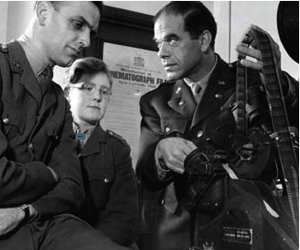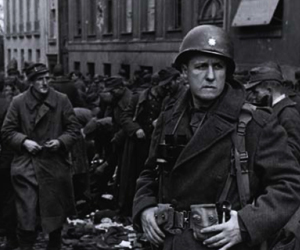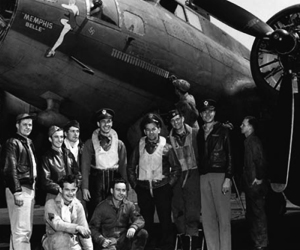BY JEFFREY RESSNER
 IN THE ARMY NOW: Frank Capra, who enlisted as a major in the
IN THE ARMY NOW: Frank Capra, who enlisted as a major in the
Army Signal Corps, made the Oscar-winning Why We Fight series
by adding this own narrative to enemy footage. Designed for
servicemen, it was releaed theatrically. (Credit: EVERETT)
"CHARGE!" The battle cry reverberated throughout the Victorian mansion set used for the film version of Arsenic and Old Lace, as Cary Grant and the ensemble of actors portraying a family of lunatics ran around a Warner Bros. soundstage in Burbank. Convinced that he’s Theodore Roosevelt, the delusional character “Teddy” storms up the grand staircase - which he believes is San Juan Hill - screaming at the top of his lungs for his troops to follow him into the fray: “Charge!” Director Frank Capra spent seven weeks shooting this macabre comedy in October and November 1941. Then, with just a single week to go, Japan attacked America’s naval base at Pearl Harbor on Dec. 7.
No one was working on that fateful Sunday, but when the cast and crew returned to the Burbank set the following morning, the emotions were overwhelming. “There they were, filming this hysterically funny comedy about murder and mayhem, and, suddenly, the entire world shifted under their feet,” recalled film historian Jeanine Basinger, a longtime friend of the director. Capra, a WWI veteran already well into his 40s, had volunteered his services as the dark storm clouds of war gathered over Europe earlier that year. On Dec. 12, just five days after Pearl Harbor, he signed up for the Army’s Signal Corps with a major’s commission and was ordered to report for active duty in mid-January. (Granted a month-long extension to finish Arsenic and Old Lace, he left for Washington on Feb. 11.)
Why return to the military’s “iron dictatorship,” he asked rhetorically in his 1971 autobiography, The Name Above the Title? Why, especially when it meant declining multi-million dollar studio deals that would have given him the financial security he had long desired? For his part, Capra said he was simply “bored” with his success and was nagged by “a guilty conscience,” championing the downtrodden on screen while beginning “to live like the Aga Khan” in Hollywood. Hollywood was well situated to mobilize for war, and film directors were essential in educating both the public, who wanted to know just why war was necessary, and new recruits, who needed to quickly learn how to use highly technical military machinery. As The Wall Street Journal noted in a January 1942 front-page story: “The movie industry’s production facilities were ready for immediate utilization in the war effort. There was no problem enlarging its ‘plant capacity’ - its chief ‘raw material’ is talent.”
So as of Dec. 7, most of Hollywood, like the rest of the country, turned its attention to the war effort. In a 1942 Christmas greeting to members, Guild President George Stevens noted that “many of you are stationed at the far corners of the globe, doing your part in finishing the biggest and most important production on which you have ever worked.” By the end of 1944, more than 6,000 Hollywood workers - including 143 directors - had signed on for active duty. “There were a few men in Hollywood who, as soon as war was declared, were in uniform,” recalled John Huston in the 1984 documentary George Stevens: A Filmmaker’s Journey. “There was Willie Wyler, Jack Ford, Anatole Litvak, Frank Capra and, of course, there was George.” Added novelist-screenwriter Irwin Shaw, who also served as a photographer in the Signal Corps: “These were men way past military age who were all rather pacifistic - not when it came to dealing with studio heads or, perhaps, in a nightclub brawl, but very liberal men who had grown up with pacifistic ideas. One and all, they gave up very lucrative and prestigious careers and went right into the Army.”
“It was a sense of duty - as simple as that,” says George Stevens Jr., who directed the documentary about his father and often spoke with him about his wartime service. “My father was 36 years old and had a family, very far from being draft-eligible, but this was something he chose to do.” The war against fascism trumped all else, and Hollywood’s directors strategized with Washington about how to best use their creative talents. A little more than six months after Pearl Harbor, The Hollywood Reporter ran a banner headline announcing “U.S. Will Film Every Battle,” noting how the War Department intended to embed cameramen with each unit and shoot all conflicts for use in news, training films, and features. But the cameramen couldn’t do it on their own - directors with strong narrative styles and storytelling sensibilities were in demand in both the European and the Pacific theaters, as well as keeping American audiences gung-ho in stateside movie theaters. Stevens, Capra, and other directors repeatedly screened German documentarian Leni Riefenstahl’s Triumph of the Will, figuring out how to counter (and copy) its effective propaganda techniques.
Capra would go on to become one of the most productive members of the Allied effort, producing the Oscar-winning Why We Fight series of war documentaries, and directing or co-directing three of its seven chapters. His most brilliant innovation may have been using enemy footage and, through parallel editing, placing his own narrative on the soundtrack, thereby contrasting the nefarious Axis ideologies with traditional homespun American values. Originally crafted to inspire servicemen, the series proved so powerful it was later released theatrically as well.
Perhaps more than any other director, the intense, tough-minded John Ford - already a legendary filmmaker when he volunteered for WWII at the age of 47 - played a key role connecting Hollywood to the war effort. As a U.S. Navy commander, Ford directed several documentaries and won two Oscars during the war years, one for 1942’s The Battle of Midway and another the following year for December 7th. The director behind The Grapes of Wrath and How Green Was My Valley made every kind of film during the war years, from a melodramatic sex hygiene short to a powerful documentary about a squadron heading out on the last mission of their lives. Ford was wounded in the left arm while filming Japan’s attack on Midway in which he spotted and reported 76 incoming enemy planes while perched atop the island’s power plant. He also shot the historic battle on Omaha Beach during D-Day as head of the Office of Strategic Services’ field photographic unit. (Very little footage was ever released of Ford’s D-Day shoot, however, with the director claiming the government feared showing massive American casualties; to this day, his full-color film has never surfaced.) Ford later served in the U.S. Navy Reserve, ending his wartime output with a 1945 feature film about PT boat battles, They Were Expendable. When asked after Midway whether he was editing propaganda films for the military or making movies for the public, Ford was typically brusque. “It’s for the mothers of America,” he barked. “It’s to let them know that we’re in a war, and that we’ve been getting the shit kicked out of us for five months, and now we’re starting to hit back.”
Perhaps more diplomatic was Stevens, best known for directing Gunga Din and lighter comic fare before he responded to Gen. Eisenhower’s request for professional filmmakers to record the battle of Europe for posterity. The U.S. Army’s Signal Corps appointed Stevens producer of the Allied Expeditionary Forces’ special coverage film unit, and he shot the only existing Allied color footage of the 1944 D-Day invasion, as well as the liberation of Paris, the first meeting of U.S. and Soviet forces, the surrender of German commanders in France, and horrifically moving scenes of the Dachau concentration camp, later shown at the Nuremberg Trials. After the war, Stevens said that “films were much less important to me and, in a way, perhaps more important.” His son adds, “The fact that all these men had a war in mid-career made them more interesting directors. War is a deep and rich experience, and what makes a director great other than their life experiences?”
 ROUGH RIDERS: George Stevens shot the
ROUGH RIDERS: George Stevens shot the
only existing Allied color footage of D-Day.  John Ford won two Oscars for his war documentaries.
John Ford won two Oscars for his war documentaries.  William Wyler (fourth from right) with much of the crew of the
William Wyler (fourth from right) with much of the crew of the
Memphis Belle.
(Photos: AMPAS/THE
LILLY LIBRARY, INDIANA UNI.)
Also signing up was Huston, a world-class adventurer and fledgling director when he entered the Army as a lieutenant in the Signal Corps, assigned to make documentaries. His first film, Report from the Aleutians (1943), received acclaim for its accurate depiction of servicemen fighting loneliness and boredom, while his second, The Battle of San Pietro (1945), was deemed too much of an anti-war tract by the Pentagon brass until Gen. George C. Marshall thought it would make a great training film to prepare young recruits for combat. Huston’s third and final Signal Corps documentary, Let There Be Light (1946), profiled a group of returning shell-shocked soldiers suffering from post-battlefield stress, and was so profoundly disturbing that the War Department barred its release for well over a quarter century.
"For some reason," explained Huston in 1976, four years before the Defense Department eventually cleared the film for public showings, “to see a psyche torn asunder is more frightening than to see people who have physical wounds.”
William Wyler had won his first Oscar for the 1942 drama Mrs. Miniver, about Britain’s struggles against the Nazis. The film was hailed as “a war movie without a single battle scene,” but Wyler came close to becoming a war casualty himself. Serving in the U.S. Army Air Forces and driving around Italy where he filmed bomb damage and other imagery, Wyler and fellow director John Sturges were heading to an Allied command post near Florence when they were spotted by a German tank with an 88mm cannon.
"That gun could cut a telephone pole a mile away, and it made a helluva noise,” Sturges told Wyler biographer Jan Herman. “All these sounds were rushing over our heads, but one of them was different. The guy with us said ‘Drop!’ Willy and I fell into a shallow ditch. I remember a whistling sound and a big explosion. All the bushes and grass around the top of the ditch were cut.” Two more shots by the tank also missed, but it was a close call.
Wyler directed two feature-length documentaries about fighter bombers - 1944’s The Memphis Belle: A Story of a Flying Fortress and, co-directing with Sturges, Thunderbolt (shot in 1945, released in 1947). Aerial footage for Memphis Belle was mostly culled from actual 1943 missions with some recreations. Yet the documentary was not made without sacrifice - a B-24 Liberator aircraft carrying cinematographer/soundman Lt. Harold Tannenbaum was shot down over the Atlantic during filming, and Wyler lost most of his hearing in one ear when an anti-aircraft shell exploded near him.
Just as Mrs. Miniver provided Americans with a cinematic preamble to WWII, its coda was delivered with Wyler’s The Best Years of Our Lives (1946), which dealt with the numerous problems faced by returning veterans. As he repeatedly told interviewers, no subject was more important. The director won another Academy Award as the picture swept the Oscars that year, and it also vastly outperformed Mrs. Miniver at the U.S. box office to become the highest-grossing film since Gone with the Wind.
On the home front, the Directors Guild acted in a variety of meaningful ways. At the request of the War Priorities Board, the Guild adapted measures in 1942 to conserve negative and positive film stock, which required chemicals used to manufacture gunpowder.
Fundraising was an ongoing activity in Hollywood and to do its part the Guild organized a National War Chest Drive consisting of directors from each of the studios. The committee was chaired by George Marshall, who, at an October 1943 meeting noted that the purpose of the group was “to get as many of the directors and assistant directors to make their contributions through the Guild.” Utilizing Hollywood’s greatest resource - star power - the Guild organized the Hollywood Victory Canteen to raise money for the Army-Navy Relief Fund. Directed and produced by Mark Sandrich with help from AD Arthur Jacobson, the caravan traveled around the U.S. in a 10-car private train carrying many of the top stars of the day, stopping for performances around the country. In addition to his work organizing the show, Sandrich headed the Guild’s Directors Coordinating Committee for the national war effort. Soliciting the cooperation of the other Guilds, Sandrich and other committee members, including Cecil B. DeMille, Howard Hawks and Rowland V. Lee, approved a proposal in April 1942 calling for the Guilds to join forces and actually produce films “calculated to appeal to the patriotic side of the theater going public and to stimulate greater endeavors in the national war effort.” This mini-wartime film studio would be funded by profits from the movies and government contributions with members offering their services at minimum scale.
Other top talent was called on to direct theatrical features, documentaries and close to 300 specific training films, such as a dry five-parter on The 37mm Anti-Aircraft Gun Battery, another on The 240mm Howitzer: Its Personnel and Equipment, the more exciting Basic Principles of Skiing, and, perhaps most revealing of the period, the three-part Sex Hygiene, an instructional short with dramatic sequences directed by Ford and featuring future Superman actor George Reeves. The short’s producer, Lt. Col. Darryl F. Zanuck, reportedly asked Army medics for a real syphilis victim who could provide a visual warning to libertine servicemen.
According to one account, Zanuck was so unimpressed with the Army’s selection for the syphilis victim that he marched the poor fellow over to the makeup department for an even more monstrous makeover. Wrote one critic, “Sex Hygiene has everything you could look for in a Ford picture - humor, emotion and a kind of rugged honesty about human relationships.” Another training film, the Oscar-nominated Resisting Enemy Interrogation, directed by U.S. Army Air Forces Capt. Robert Sinclair, instructed potential POWs how to behave if captured by Nazis and was deemed “as exciting as any Hitchcock thriller.” Hitch himself, a British citizen at the time, is not generally known as a major contributor to the war effort. “I was both overweight and overage for military service,” he told Francois Truffaut. “[But] it was important for me to do something and also to get right into the atmosphere of war.” Several of his most memorable films cast Axis evildoers as their villains, from 1942’s Saboteur (which began shooting two weeks after Pearl Harbor and climaxes with a fight atop the Statue of Liberty) to 1946’s Notorious (about Nazi spies smuggling uranium in South America). In addition, Hitchcock directed uncredited shorts about the United Nations and the French Resistance, as well as trailers selling war bonds.
In mid-1945, Hitchcock agreed to serve as “treatment adviser” on a concentration camp documentary for Allied distribution specifically to influence German audiences. The U.S. decided to develop its own project, but Hitchcock worked on a British-funded version and gave cameramen instructions for entering the camps - specifically requesting “long tracking shots, which cannot be tampered with” so no one could claim the material had been manipulated, according to Patrick McGilligan’s biography of Hitchcock, A Life in Darkness and Light. After the film was shot and edited without sound, funding was withdrawn and an hour-long cut was sent to Britain’s Imperial War Museum, where it was unseen by the public until 1984. (The U.S. version, Die Todesmühlen aka The Death Mills, was directed by Austrian émigré Billy Wilder and released in Germany’s American zone in early 1946.) Created by an executive order in June 1942, the new Office of War Information (OWI) was the government’s specially created propaganda arm, and OWI formed the Bureau of Motion Pictures (BMP) to specifically network with Hollywood, originally distributing how-to manuals and, later, actually having representatives present on film sets to approve war-related issues. By the end of 1943, every Hollywood studio (except Paramount) gave OWI carte blanche to review both early screenplay drafts and final scripts.
Aside from making films for the war effort, the OWI joined with Hollywood’s War Activities Committee (WAC) to distribute regular studio features in 16 mm for screenings on military bases, battleships, command posts, and other sites. Grunts could watch the latest Andy Hardy features or Betty Grable comedies just as their families were doing stateside. By 1943, the OWI-WAC distribution network was operating smoothly, and that year the studios delivered 218 features to the War Department, some far ahead of their theatrical release.
Indeed, in early 1943 while Capra was stationed in London, he noticed American GIs in Piccadilly Circus and thought he overheard an old yet familiar battle cry. Later, as he dined with the Royal Air Force Film Unit at Pinewood, a group of British soldiers ran around the mess hall brandishing imaginary cutlasses and yelling “Charge!” Capra pointed at them and gulped, “You guys have seen Arsenic and Old Lace!” As it turned out, Jack Warner had allowed the film to be screened on military bases that January, more than a year before it was released in the U.S. Capra couldn’t help but be amused. He called Warner “an old softy” for releasing early 16 mm prints of the zany comedy to soldiers. He was even more gratified when he learned that Yanks in uniform were regularly being greeted overseas with “batty Teddy’s” absurdist catchphrase.
But once he and his fellow directors had seen active service in the war, “Charge!” would never carry the same meaning for them again.